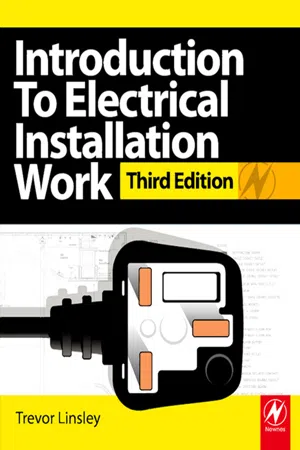
- 235 pages
- English
- ePUB (mobile friendly)
- Available on iOS & Android
Introduction to Electrical Installation Work
About This Book
This introductory guide to electrical installation work provides all the key concepts and practical know-how you need to pass your course, minus the difficult maths and complicated theory
Written in a clear, readable style and with a highly visual layout, this book will quickly provide you with the all-important knowledge you need to understand electrical installation work. End of chapter revision questions will help you to check your progress, and online animations and video demonstrations will help you get to grips with relevant theory and practice. Designed to match the 17th edition of the IEE Wiring Regulations and the new City & Guilds 2357 Diploma in Electrotechnical Technology, this book covers everything you need to get started on your path towards a career in electrical installation or related trades.
Also available:
Basic Electrical Installation Work 6th edition
Trevor Linsley
ISBN: 9780080966281
Frequently asked questions
Information


- The purpose of the HSAWA is to provide the legal framework for stimulating and encouraging high standards of health and safety at work.
- The Act places the responsibility for safety at work on both workers and employers.
- The HSAWA is an ‘Enabling Act’ which allows the Secretary of State to make further regulations and modify existing regulations to create a safe working environment without the need to pass another Act of Parliament.
- These regulations are made under the Health & Safety at Work Act and are enforced by the Health & Safety Executive (HSE).
- The purpose of the regulations is to ‘require precautions to be taken against the risk of death or personal injury from electricity in work activities’.
- An electrical installation wired in accordance with the IEE Regulations BS 7671 will also meet the requirements of the EWR.
- These regulations are designed to ensure a proper and safe supply of electrical energy up to the consumer’s mains electrical intake position.
- They will not normally concern the electrical contractor, except in that it is these regulations which set out the earthing requirements of the supply.
- To comply with the Health & Safety at Work Act employers must have ‘robust health and safety systems and procedures in the workplace’.
- Employers must ‘systematically examine the workplace, the work activity and the management of safety through a process of risk assessment’.
- Information based upon the risk assessment findings must be communicated to relevant staff.
- So, risk assessment must form a part of any employer’s ‘robust policy of health and safety’.
- These regulations place a general duty of care upon employers to ensure minimum requirements of plant and equipment used in work activities.
- If an employer has purchased good quality plant and equipment, and that plant and equipment is well maintained, there is little else to do.
- The Control of Substances Hazardous to Health Regulations (COSHH) control people’s exposure to hazardous substances in the workplace.
- Employers must carry out risk assessments and, where necessary, provide PPE (Personal Protective Equipment) so that employees will not endanger themselves.
- Employees must also receive information and training in the safe storage, disposal and emergency procedures which are to be followed by anyone using hazardous substances.
- PPE is defined as all equipment designed to be worn or held in order t...
Table of contents
- Cover
- Halt Title
- Title Page
- Copyright
- Contents
- Preface
- Chapter 1. Working effectively and safely in an electrical environment
- Chapter 2. Basic principles of electrotechnology
- Chapter 3. Health and safety application and electrical principles
- Chapter 4. Installation (building and structures)
- Chapter 5. Environmental technology systems
- Solutions to assessment questions
- Appendix A: Environmental organizations
- Index